Service and combat use of captured German heavy field 105 mm guns and 150 mm heavy howitzers after the end of World War II
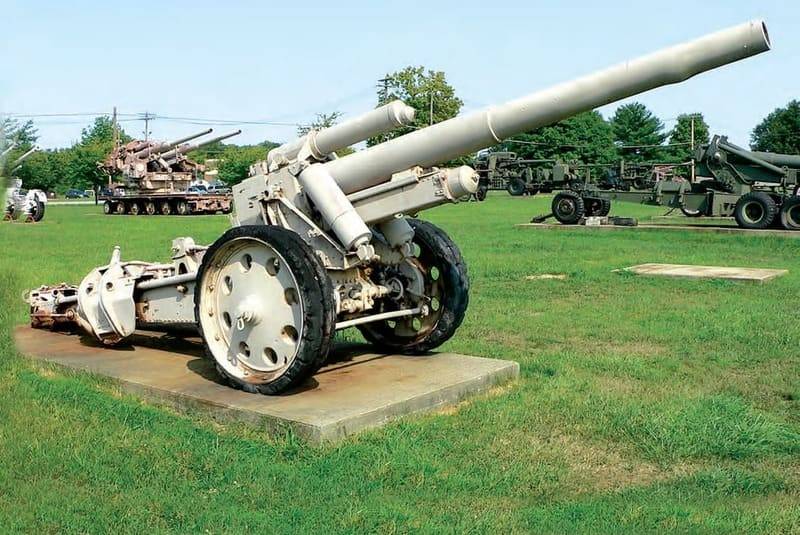
When talking about the use of captured German artillery, one cannot ignore the 105-mm field guns and 150-mm heavy howitzers, which were used in the divisional level and in the artillery units of the reserve of the main command. In general, these were very good artillery systems for their time, capable of successfully competing with guns of similar purposes created in other countries.
After the end of World War II, German 105-mm long-range guns and 150-mm heavy howitzers, created with a good margin of safety and having a long service life, were in service in a number of European, Middle Eastern and Asian countries. In some countries they have been modernized, which has improved their performance and extended their service life. These artillery systems, produced in the Third Reich, participated in many post-war regional conflicts and finally disappeared from the scene in the XNUMXst century.
105 mm heavy field gun 10,5 cm sK18
At the end of the 1920s, the Rheinmetall-Borsig AG and Friedrich Krupp AG concerns secretly began to create a 105-mm long-range gun, which was supposed to replace the heavy 10 cm K.17 cannon (German: 10 cm Kanone 17 - 10-cm gun model 1917). Despite the fact that the official designation of the gun was called “10 cm”, its true caliber was 105 mm.
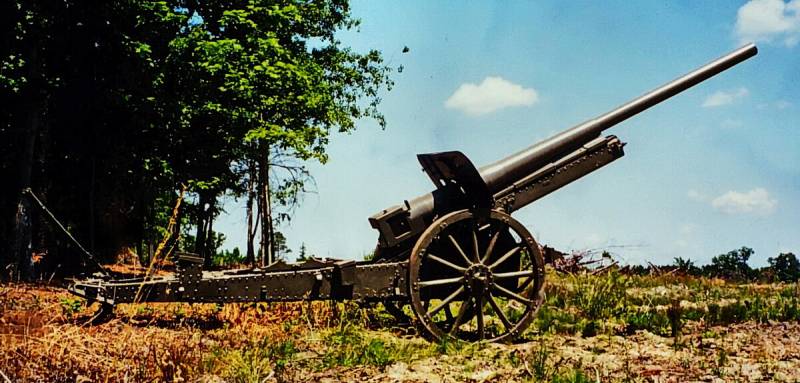
105 mm heavy gun 10 cm K.17
The K.17 gun had a good firing range (16,5 km), but already 10 years after the end of the First World War it became clear that the gun with a single-timber riveted carriage, wooden wheels, lack of suspension and small horizontal aiming angles had no further prospects.
In parallel with the creation of a new 105-mm heavy gun, the design of a 150-mm howitzer unified with it on the carriage was carried out, which was supposed to reduce design and manufacturing costs, as well as facilitate operation by the troops.
The first prototypes appeared in 1930, but development was delayed, and the guns were handed over for military testing only in 1933. This was largely due to the fact that before the Nazis came to power, Germany at least formally tried to comply with the restrictions imposed by the Treaty of Versailles, and the German government tried to avoid accusations of creating new types of weapons. On the other hand, a relatively long testing and development process by the standards of the 1930s made it possible to put into production quite good artillery systems and eliminate most of the “childhood diseases”.
After careful testing of guns provided by competing firms, the military chose the Rheinmetall barrel and Krupp carriage. Thus, both of the largest German manufacturers of artillery weapons received their piece of the pie from a very profitable order.
In general, the success of the 105–150 mm “duplex” was largely due to the successful carriage with sliding frames, which had three support points. In terms of stability, the Krupp carriage was close to a carriage with a cruciform base.
The use of sliding frames led to a significant increase in the weight of the new 105 mm gun. Compared to the K.17, the weight in combat position increased by 1,7 times (from 3 to 300 kg). But this made it possible to expand the guidance sector in the horizontal plane from 5° to 642°. The maximum vertical aiming angle was +6°. In extreme cases, firing with the frames closed was allowed. But in this case, the horizontal and vertical aiming angles were limited.
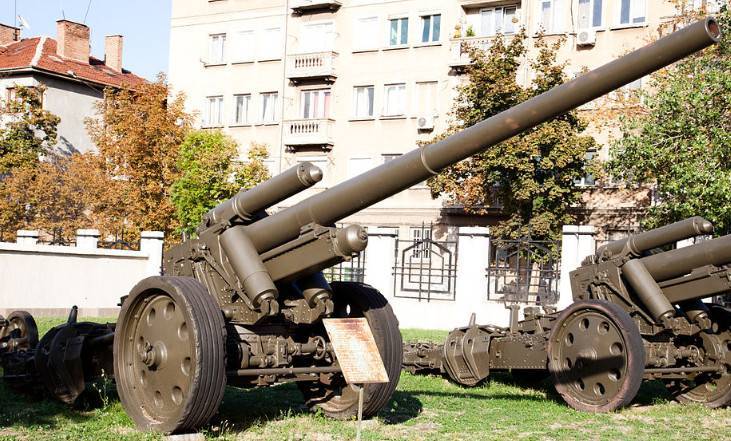
105 mm heavy field gun 10,5 cm sK18 on museum display
The gun, designated 10,5 cm sK18 (in German 10,5 cm Schwere Kanone 18 - 10,5 cm heavy gun model 1918), was put into mass production in 1936. Sometimes the name 10 cm sK18 is also found.
The production of carriages was carried out only by the concern Friedrich Krupp AG. The barrels were manufactured at Friedrich Krupp AG and Rheinmetall-Borsig AG. Gun barrels manufactured by different factories differed in details, but were interchangeable. The cost of one gun was 37 Reichsmarks, which was 500 times higher than the price of the 2,28 mm howitzer 105 cm le.FH.10,5.
Shots with separate cartridge loading were used to fire from a 105-mm heavy field gun. Depending on the range, three numbers of powder charges were placed in a brass or steel case 445 mm long: small (weight 2,075–2,475 kg depending on the type of gunpowder), medium (2,850–3,475 kg) and large (4,925–5,852 kg). When firing a high-explosive fragmentation grenade, a small charge provided an initial speed of 550 m/s and a maximum firing range of 12 m. Medium - 725 m/s and 690 m, respectively. Large - 15 m/s and 750 m. A well-trained crew could fire 835 shots per minute.
The main projectile was a high-explosive fragmentation grenade 10,5 cm Gr. 19 weighing 15,14 kg, which was equipped with a charge of cast TNT weighing 1,75 kg. In addition to the main explosive charge, to ensure better visibility of the explosion, there was a stick of red phosphorus in the bottom part, which gave a clearly visible cloud of white smoke.
To combat tanks The ammunition included a 10,5 cm Pz.Gr armor-piercing projectile. Rot weighing 15,6 kg. Its initial speed was 822 m/s. At a distance of 1 m, this projectile could normally penetrate 000 mm armor, which ensured a confident defeat of all production heavy tanks that took part in World War II.
To set up a smoke screen and sometimes for sighting, a 10,5 cm Gr smoke projectile was used. 38 Nb weighing 14,71 kg.
At the time of the creation of the 10,5 cm sK18 gun, the German army did not have suitable means of mechanized traction, and therefore a separate carriage of the barrel and carriage was used.
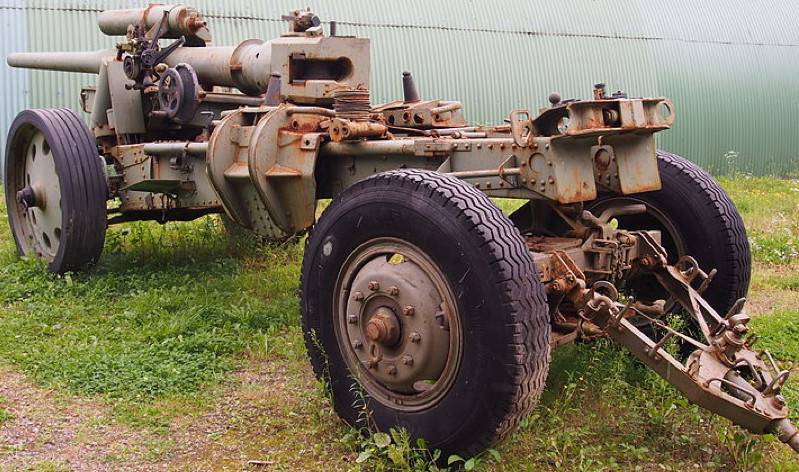
The gun was disassembled into two parts and transported on gun and carriage wagons. For horse traction, teams of six horses were used. The towing speed reached 8 km/h. When disassembled, the 105-mm cannon could also be towed by mechanical traction at speeds of up to 40 km/h on a paved highway.
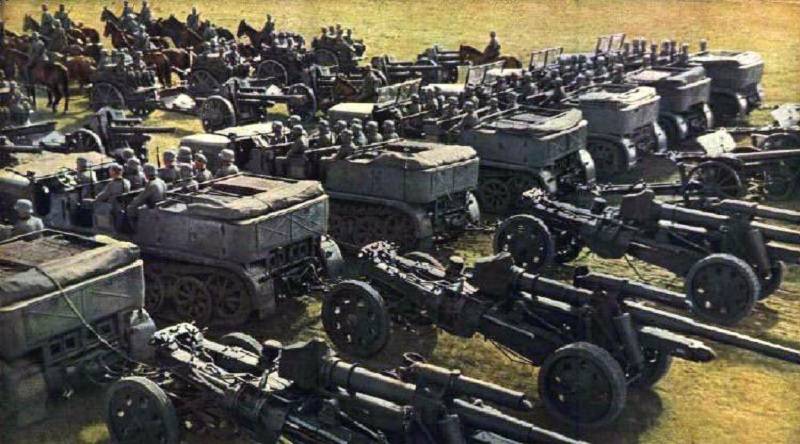
For horse-drawn carriage, all-metal wheels were used; for mechanical traction, metal wheels with a rubber cast rim were used. A crew of 9 people transferred the gun from traveling to firing position in 8 minutes.
After transportation began to be carried out by half-track tractors, it became possible to abandon the disassembly of 105 and 150 mm guns, and with undivided transportation, the time for transferring to a combat position was halved. To tow the gun with a tractor, the barrel was moved to the stowed position.
Based on the experience of combat use, in 1941 they released a modernized version of the 105 mm gun, known as the 10,5 cm sK18/40. During the modernization, a more technologically advanced carriage was introduced. To increase the firing range, the barrel was lengthened by 8 calibers, and the weight of the large powder charge was increased to 7,5 kg. Such a weapon could send a projectile 21 km. Subsequently, in 1942, a gun known as the 10,5 cm sK18/42 went into production, with changes aimed at strengthening the design. At the same time, the mass of the gun increased to 6 kg.
By September 1, 1939, the troops had 702 10,5 cm sK18 guns. At the first stage, German generals believed that this number of 105-mm long-range guns was quite enough, and their production was carried out at a low rate. In 1940, the industry delivered only 35 such guns, and in 1941 and 1942, 108 and 135 guns, respectively.
Significant losses suffered on the Eastern Front required a sharp increase in production volumes. And in 1943, 454 guns were sent to the troops. And in 1944, 701 guns were produced. Until February 1945, German factories were able to produce 74 units. Thus, the armed forces of Nazi Germany received 2 209 mm long-range guns.
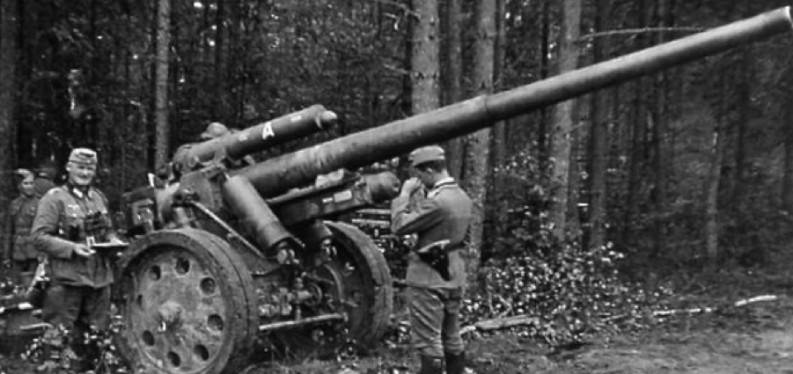
10,5 cm sK18 guns were available in mixed artillery battalions attached to some motorized, tank and infantry divisions. The division had two batteries of 150 mm heavy field howitzers and one of 105 mm guns.
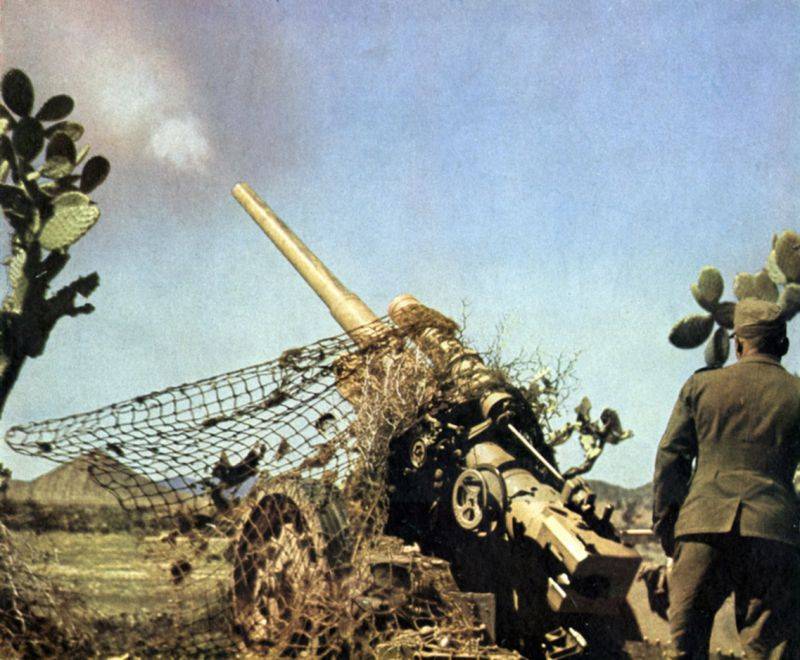
German artillerymen fire a 105mm heavy field gun in North Africa
105-mm long-range cannons were also used as part of the artillery of the RGK - in three-battery cannon divisions. It is known that several batteries armed with 105 mm sK18 defended the Atlantic coast.
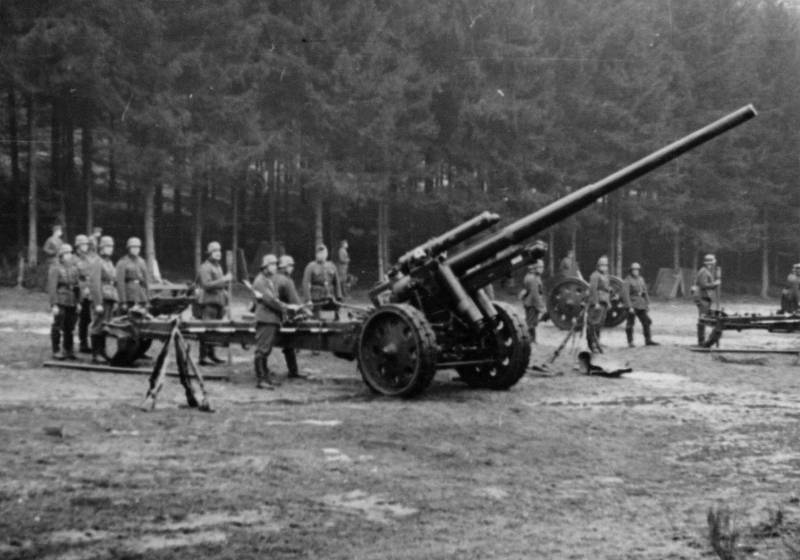
The heavy 105-mm sK18 field gun proved to be a fairly effective means of hitting weakly protected targets deep in enemy defenses and was often used for counter-battery warfare. At the same time, the power of a 105-mm projectile was often not enough to destroy long-term defensive structures.
In 1941–1942 10,5 cm sK18 guns, along with 88 mm anti-aircraft guns, were perhaps the only German artillery systems capable of reliably penetrating the frontal armor of heavy Soviet tanks.
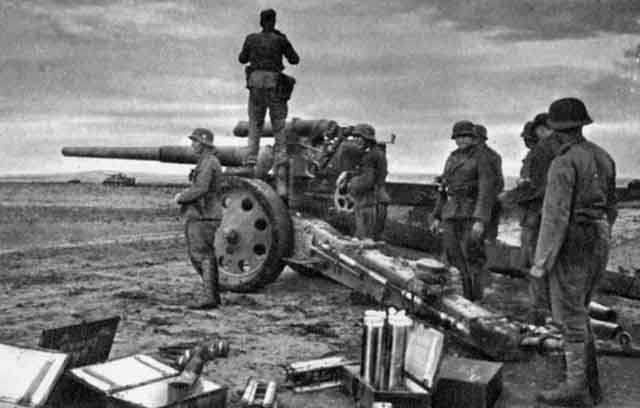
Although it was irrational to place such expensive and heavy artillery systems under direct fire, such use of 105 mm guns occurred throughout the war. When firing at tanks, large guns were clearly visible. In addition, in order to reduce weight, long-range guns did not have an armor shield to protect the crew in front from bullets and shrapnel.
Comparison of the German 105 mm heavy field gun 10,5 cm sK18 with the Soviet 107 mm M-60 field gun
In the Red Army, the closest analogue of the 10,5 cm sK18 can be considered the 107 mm M-60 mod. 1940, which was originally developed for use in divisional artillery.
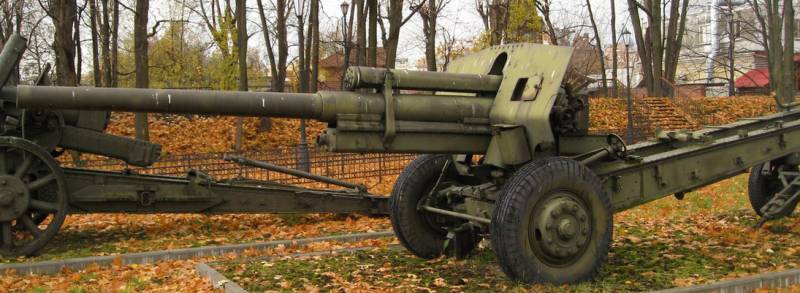
107-mm M-60 field gun on display at the museum
In terms of firing range, the Soviet gun was slightly inferior to the German one (18 m versus 300 m). At the same time, the 19-mm Soviet OF-075 high-explosive fragmentation projectile weighed 107 kg, and the German 420 cm Gr. 17,2 – 10,5 kg. The Soviet gun was much lighter. The mass of the M-19 in combat position was 15,4 kg (60 kg in the stowed position with the front end), and the mass of the sK4 was 000 kg in the combat position and 4 kg in the stowed position.
Often German 105 mm 10,5 cm sK18 cannons and Soviet 107 mm M-60 guns fired direct fire at armored vehicles. Although these guns were not originally intended for this purpose, in war any artillery system that came within the range of which enemy tanks appeared became anti-tank. In this role, the Soviet gun, which had a rate of fire of up to 7 rounds/min and was equipped with an armor shield, looked preferable.
Use of captured 10,5 cm sK18 guns in the Red Army
German 105 mm long-range guns were considered a valuable trophy by the Red Army throughout the war. Soviet troops managed to capture the first copies of the 10,5 cm sK18 during the counteroffensive near Moscow in the winter of 1941–1942.
A significant part of the captured 105-mm guns were received in a faulty condition. This was due to the fact that German artillerymen in the first year of the war on the Eastern Front were not ready to operate their guns in severe frosts. When the temperature dropped below -20° Celsius, the liquid used in the recoil device became very thick, and the gun quickly failed when fired.
However, through the efforts of repair teams from front-line artillery workshops, some 105-mm guns were returned to service, and the first 4-gun battery appeared in the Red Army in February 1942.
The next time, approximately two dozen 10 cm sK18 cannons suitable for further use and a significant number of rounds for them were at the disposal of the Red Army about a year later, after the surrender of the 6th German Army, surrounded at Stalingrad.
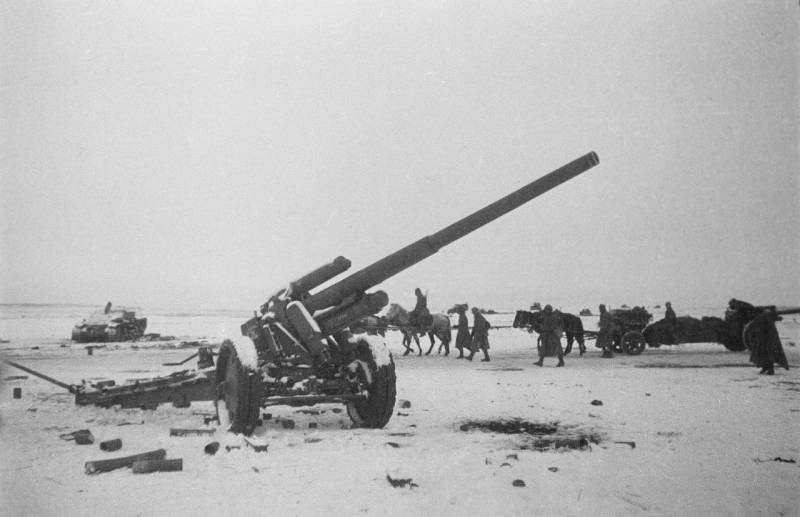
After the transition of the Red Army to large-scale offensive operations, German 105-mm long-range guns began to regularly be among the trophies captured by the Red Army. As a rule, these were guns abandoned at positions due to the impossibility of evacuation or due to the failure of tractors. Sometimes surviving guns could be found among the broken equipment of German military columns destroyed by our attack aircraft on the march. Since the spring of 1944, captured 10,5 cm sK18s began to be constantly used against their former owners.
Captured 105-mm cannons were transferred to ARGC formations and fought alongside their own long-range artillery. In order to facilitate the mastery of captured guns by Soviet crews, firing tables were translated into Russian and operating instructions were issued.
Post-war use of captured 10,5 cm sK18 guns
In the post-war period, the USSR received a significant number of 105-mm guns, which were stored until the second half of the 1950s. In 1946, the reference book “Ammunition Packages of the Former German Army” was published, which describes in detail the shells for the 105 mm sK18 cannon.
It was not possible to find information about the further fate of the 105-mm long-range guns remaining in the USSR, but it can be assumed that these guns, which were valuable in counter-battery warfare, remained in reserve until the Soviet artillery units were saturated with 130-mm M-46 guns.
In 1939, Bulgaria bought a batch of 105 mm sK18 field guns, which were in service with the Bulgarian army until the early 1960s.
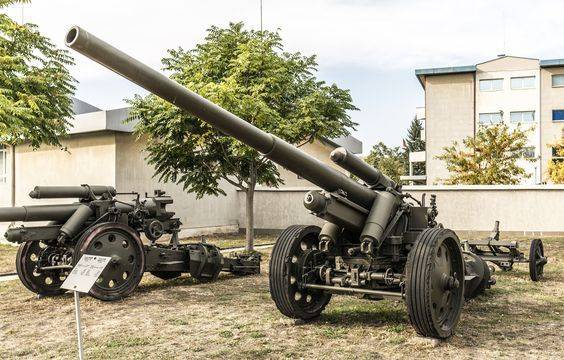
105 mm sK18 gun in the National Military History Museum, Bulgaria, Sofia
10,5 cm sK18 guns were also available in the armed forces of other states. In the post-war period, approximately one and a half hundred 105 mm guns went to Albania, Czechoslovakia, France and Yugoslavia.
Heavy 150 mm howitzer 15 cm sFH18
As mentioned above, simultaneously with the creation of the 105-mm long-range sK18 cannon, the development of a heavy 150-mm howitzer was underway, which was supposed to replace the 150-mm sFH13 field howitzers, which actively fought in the First World War.
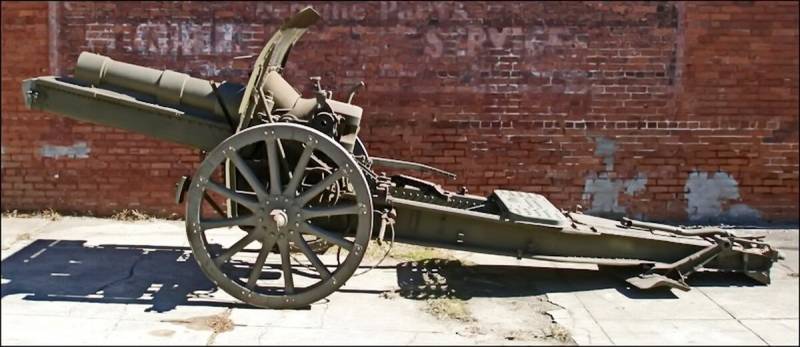
150-mm field howitzer sFH13 on museum display
In combat position, the 15 cm sFH13 howitzer weighed 2 kg. The firing range of a high-explosive fragmentation grenade weighing 250 kg was 43,5 m. The rate of fire was 8 rounds/min.
By the beginning of World War II, Germany had approximately 700 obsolete 150-mm howitzers. In 1940, German arsenals were replenished with sFH13 lg howitzers (with an extended barrel), captured in Belgium and the Netherlands.
However, German generals planned to use guns from the World War I era in secondary directions, and the much more advanced 150-mm heavy howitzers 15 cm s.FH.18 were considered the main ones for the destruction of long-term defenses and fire support at the divisional level.
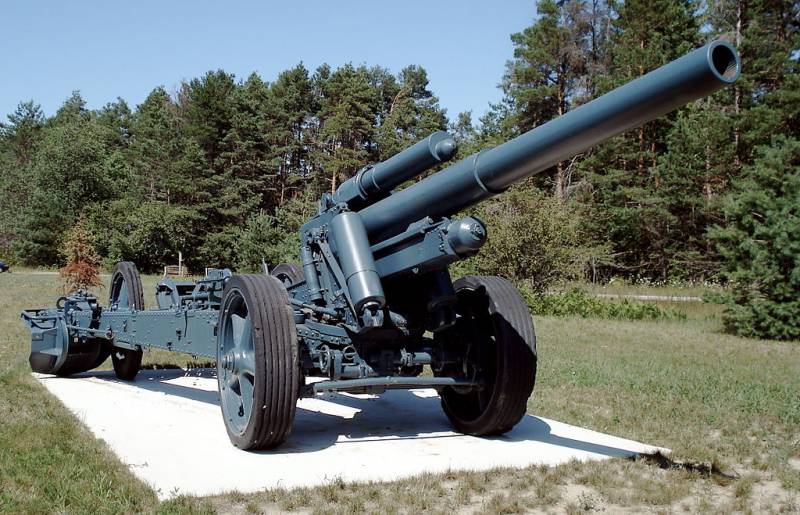
150 mm heavy howitzer 15 cm s.FH.18 on display at the museum
In combat position, the sFH18 howitzer weighed 5 kg. In stowed position – 530 kg. As in the case of the 6 mm sK100 gun, the horse-drawn 105 mm sFH18 howitzer could only be transported using a separate cart. In preparation for transportation, the barrel was removed from the carriage using a hand winch and placed on a two-axle barrel cart connected to the limber.
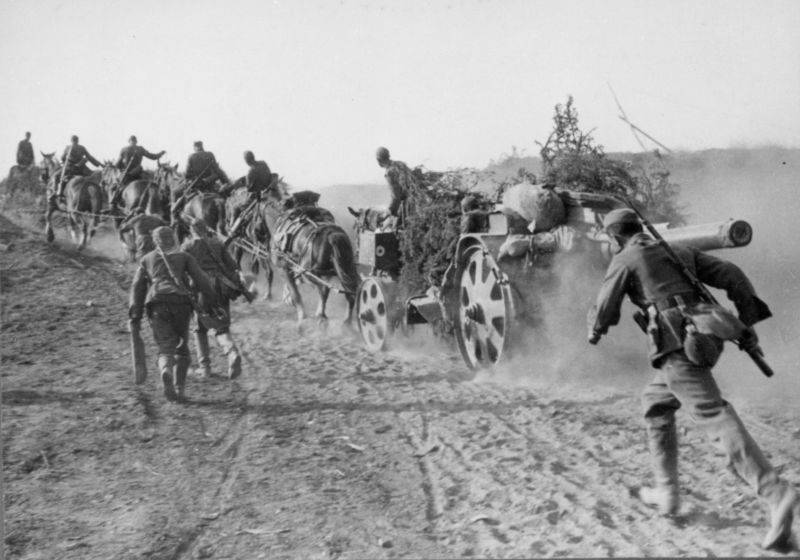
The cart with the trunk, as well as the carriage with the limber, were transported by teams of six horses. The average speed of transportation on a paved road did not exceed 8 km/h. On soft soils and rough terrain, crews often had to push carts. A prepared crew of 12 people moved the gun from the traveling position and back in 7 minutes.
When towing the howitzer with the Sd.Kfz.7 half-track tractor, the process of bringing it into the stowed position was greatly simplified: it was only necessary to remove the openers from the frames, bring the frames together, place them on the front and pull the barrel into the stowed position. All this took 3–4 minutes.
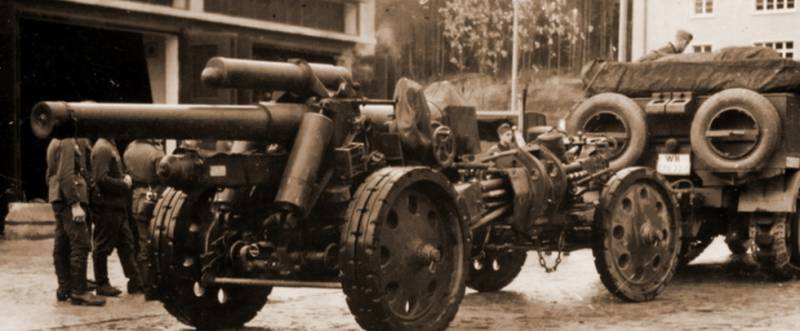
The guns, designed for horse and mechanized traction, were distinguished by carriage wheels. In the first case, all-metal wheels with a diameter of 1 mm with a steel rim were used, in the second, wheels with a diameter of 300 mm with rubber cast tires were used.
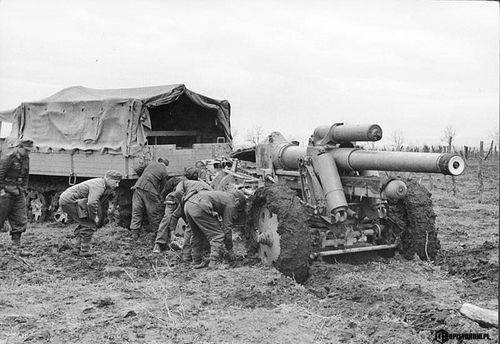
As with the 105 mm sK18 cannons, transporting 150 mm howitzers off paved roads was very difficult.
The 15 cm s.FH.18 howitzer had a barrel length of 4 mm, which, when using the maximum propellant charge, provided an initial speed of up to 440 m/s, and a maximum firing range of 520 m. Rate of fire—13 rounds/min. Vertical aiming angle: from –300° to +4°. Horizontal aiming – 3°.
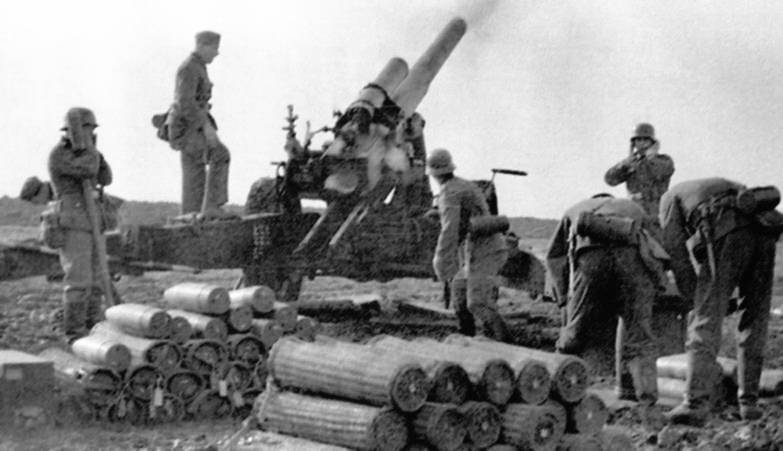
The howitzer is loaded using a separate cartridge case. Eight charges were used for firing. The use of the seventh and eighth charges was permitted only in special situations. To prevent accelerated wear of the barrel, the number of shots on these charges was limited to no more than ten in a row.
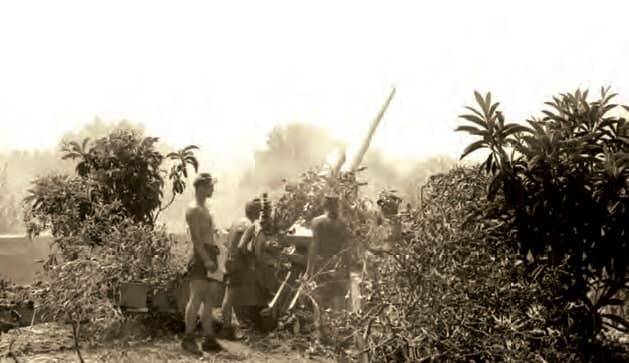
Calculation of howitzer 15 cm s.FH. 18 from the German Afrika Korps
For the most part, the shooting was carried out with a high-explosive fragmentation grenade 15 cm Gr.19 weighing 43,62 kg, loaded with 4,4 kg of TNT. This projectile had impact and mechanical remote fuses. When shooting at manpower, it was optimal to detonate using a remote fuse at a height of 10 m. In this case, lethal fragments flew forward 25–30 m and to the sides 60–65 m. When the head fuse, set to instantaneous action, was triggered, the fragments flew 20 m forward, 50 m to the sides and 6 m back. The shell could penetrate a concrete wall 0,45–0,5 m thick, a brick wall up to 3 m thick.
In 1936, an improved 150 mm high-explosive fragmentation grenade, 15 cm Gr, was developed. 36 FES with iron-ceramic drive belt. Its length increased from 615 to 680 mm, the mass of the explosive charge was increased to 5,1 kg.
Concrete-piercing blunt-headed shell 15 cm Gr. 19 Be weighed 43,5 kg and contained 3,18 kg of TNT.
The 15 cm Gr. projectile was intended for setting up a smoke screen. 19 Nb weighing 38,97 kg, containing a bursting charge weighing 0,5 kg and 4,5 kg of smoke-forming composition. When a 15 cm Gr. shell explodes. 19 Nb formed a thick smoke cloud with a diameter of up to 50 m, which, in the absence of wind, did not dissipate for more than 1 minute.
Although during the Second World War there was no tank capable of withstanding fire from 150-mm high-explosive fragmentation and concrete-piercing shells, the production of new 150-mm anti-tank ammunition began after Germany entered the war.
The 15 cm PzGr armor-piercing sub-caliber projectile was added to the ammunition load. 39 TS weighing 15 kg, capable of penetrating 1 mm armor at a normal distance of 000 m.
Also, the 15 cm Gr. cumulative projectile could be used against tanks. 39 H1/A weighing 25 kg, equipped with a 4-kg charge consisting of an alloy of TNT and hexogen. The armor penetration of this ammunition was 180–200 mm at an impact angle of 45° from the normal, which made it possible to confidently hit heavy tanks.
Even in pre-war times, the Wehrmacht command demanded that the weight of the howitzer be reduced. This was largely due to the lack of tractors, which in conditions of maneuver warfare could lead to disruption of the high tempo of the offensive.
In 1939, production of the lightweight 15 cm sFH36 howitzer began. Light aluminum alloys were used in the design of the carriage of this gun, due to which the weight in the stowed position decreased by 2,8 tons, in the firing position - by 2,23 tons. The barrel of the sFH36 howitzer became 99 cm shorter, the firing range was reduced by 825 m. To reduce recoil, a muzzle brake is applied.
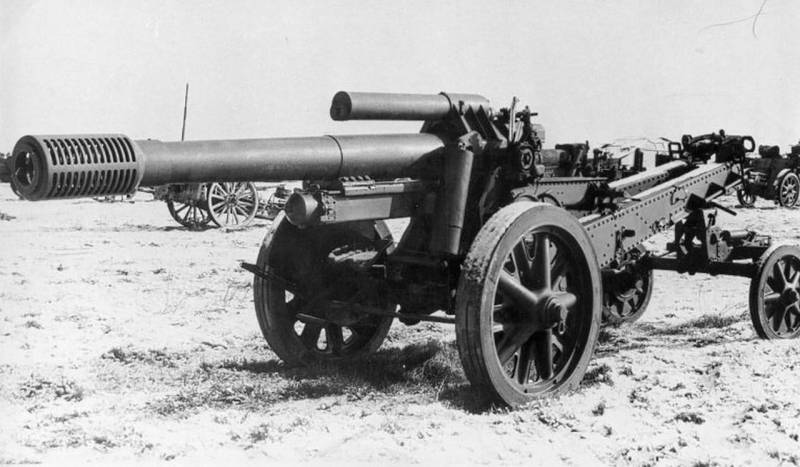
150 mm howitzer 15 cm sFH36
The weight savings achieved through the use of a light-alloy carriage and a shortened barrel made it possible to tow the howitzer with one 6-horse team. However, due to a shortage of aluminum and technological difficulties with the production of cast parts from light alloys, production of sFH36 was curtailed in 1941.
At the end of the 1930s, simultaneously with the release of 150 mm howitzers, specialists from the Friedrich Krupp AG concern were creating a new weapon that was supposed to replace the 15 cm s.FH.18.
In addition to reducing weight, the new 150-mm howitzer was supposed to have an elongated barrel, which, together with the use of shells with an iron-ceramic leading belt, made it possible to increase the firing range to 15 m. Also, the elevation angle was increased to +675°, which gave the gun the properties of a mortar.
The howitzer, known as the 15 cm sFH40, was tested and ready for mass production in early 1940. A total of seven prototypes were produced, of which four guns were transferred for military testing.
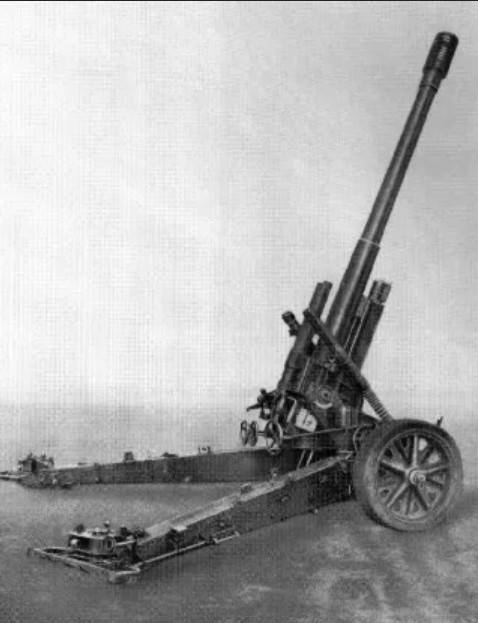
150 mm howitzer 15 cm sFH40
Despite its good characteristics and advanced capabilities, the 15 cm sFH40 was not accepted into service. The order was canceled by Adolf Hitler, who demanded first of all an increase in output weaponsalready in production.
Before the final decision was made to curtail work on the 150 mm sFH40 howitzer, several dozen barrels were manufactured for them. In 1942, these barrels were placed on the carriages of sFH18 howitzers. This modification of the howitzer was designated 15 cm sFH42. The maximum firing range of this gun was 15 m. A total of 100 46 cm sFH15 howitzers were fired.
In 1942, mass production of the 15 cm sFH18M howitzer, equipped with a muzzle brake, began. Thanks to the introduction of a muzzle brake, it was possible to reduce the recoil and the loads impacted on the gun carriage when fired. At the same time, they partially solved the problem of firing on the seventh and eighth charges by introducing replaceable inserts into the design of the charging chamber - now after wear they could be easily replaced. Whereas previously the entire barrel had to be replaced.
The 15 cm R Gr long-range active-rocket projectile was added to the ammunition load. With a mass of 45,25 kg, this projectile could fly 19 km. Thanks to this, the howitzer gained the ability to fire at targets at a distance previously accessible to 105-mm sK18 cannons. However, firing active-rocket shells was effective only when conducting harassing fire. The dispersion of such projectiles at maximum range turned out to be too great.
The baptism of fire of the 150-mm sFH18 howitzers took place in Spain, where two batteries of such guns were sent as part of the Condor Legion, which were used very effectively in battle. Subsequently, the Germans handed over these howitzers to the Francoists.
Heavy field 150-mm howitzers were used by the Wehrmacht and SS troops at all stages of the war and in all theaters of military operations. According to the staffing table, 15 cm sFH18 howitzers were available in one of the four divisions of the artillery regiment of the infantry division. The same howitzer was used in separate heavy artillery divisions, which further reinforced the troops in important directions.
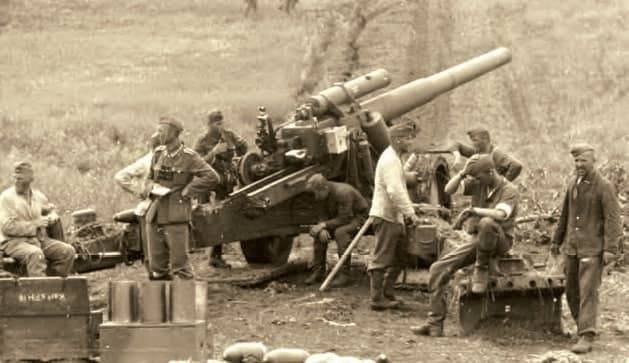
During World War II, heavy 150-mm howitzers were widely used to destroy manpower, counter-battery combat, destroy fortifications, as well as to fight armored vehicles in their starting positions and shelling targets behind enemy lines.
The gun was considered quite reliable, and its shells had great destructive power. The presence of cumulative and sub-caliber armor-piercing shells in the ammunition theoretically made it possible to use the 15 cm sFH18 to combat tanks. But in this form, a heavy howitzer was used only in exceptional cases - the large weight and dimensions of the gun, as well as the lack of shield cover, made it very vulnerable on the battlefield.
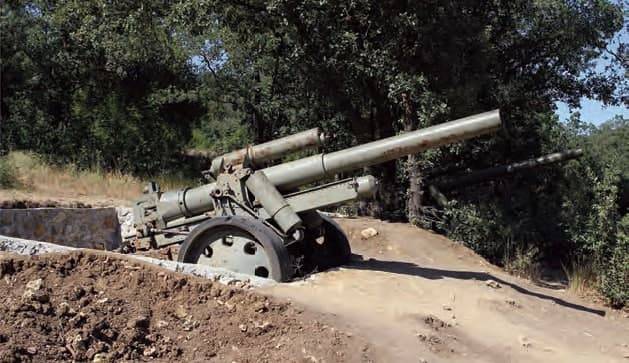
The production of 150-mm heavy howitzers from 1934 to 1945 was carried out at Friedrich Krupp AG and Rheinmetall-Borsig AG. After Germany's attack on the Soviet Union, the Czech company Skoda joined the production of such guns. The cost, depending on the version, was 38–500 Reichsmarks. 60 howitzers of all modifications were produced.
In 1941, the Italian army received 38 howitzers of this type, where they were designated Obice da 149/28. Twelve guns were transported to North Africa. These howitzers were armed with two heavy artillery batteries. In 1942, one division of 150 mm howitzers as part of the 102nd Motorized Division "Trento" went to the Eastern Front. During the fighting, most of the 15 cm sFH18 transferred to Italy was lost.
The same fate befell the guns assigned to the Spanish volunteer “Blue Division” (which was included in the Wehrmacht as the 250th Infantry Division), which fought on the Eastern Front from August 1941 to October 1943.
Comparison of the 15 cm sFH18 howitzer with foreign analogues
A comparison of the 15 cm sFH18 with the closest analogues available in the USA and USSR will be indicative.
The American 155-mm howitzer M1A2, whose production began in 1942, was slightly heavier in combat position (5 kg versus 600 kg).
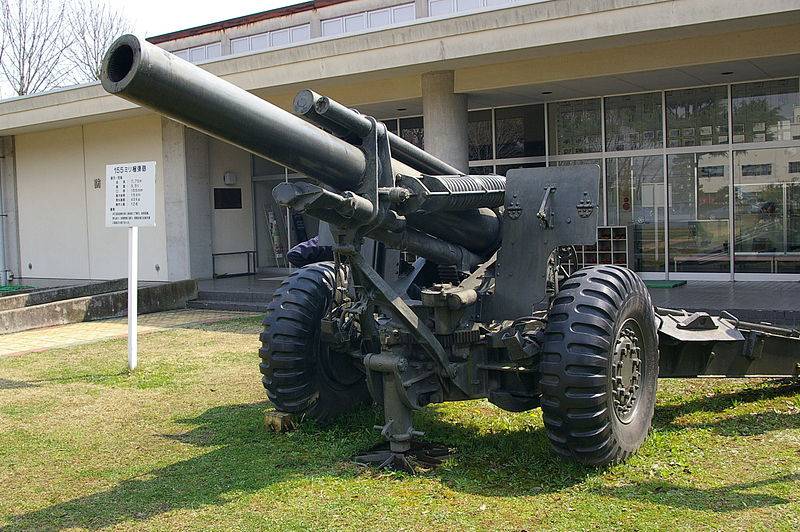
155 mm howitzer M1A2
With approximately the same weight of a high-explosive fragmentation grenade, the 155-mm M1A2 howitzer
had a maximum firing range of 14 m (the German howitzer had 600 m). In the first two minutes after opening fire, the American howitzer could fire 13 rounds per minute, and with prolonged firing - 300 rounds per minute.
The Soviet 152-mm howitzer M-10 model 1938 weighed 4 kg in combat position. And with a barrel length of 150 mm, it could send a 3-OF-700 high-explosive fragmentation projectile weighing 53 kg at 530 m. Rate of fire - up to 40 rounds/min.
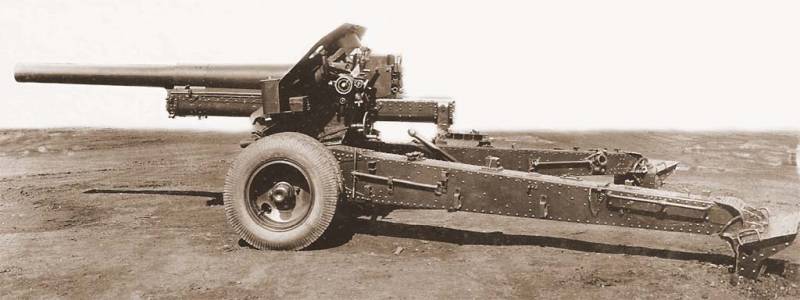
152 mm howitzer M-10
Thus, the German 150-mm heavy field howitzer sFH18 had a maximum firing range of almost a kilometer more, but was also significantly heavier.
Comparing the 15 cm sFH18 with the Soviet 152 mm ML-20 gun-howitzer, it can be noted that the Soviet gun was almost 4 km superior to the German 150 mm howitzer in firing range.
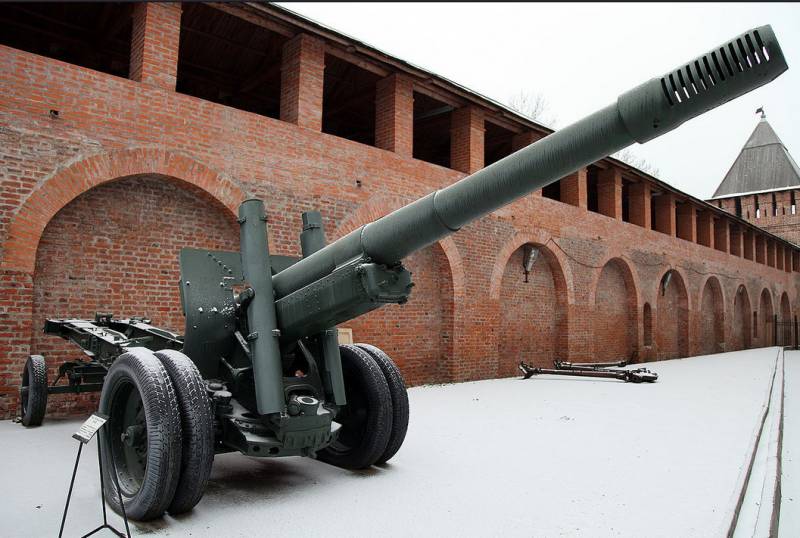
152 mm gun-howitzer ML-20
ML-20 in combat position weighed 7 kg. Thus, the Soviet artillery system was almost 270 tons heavier. To transport the ML-2, heavy tracked artillery tractors “Voroshilovets” and “Comintern” were used, which were always in short supply.
Captured heavy howitzers 15 cm sFH18 in the Red Army
As in the case of the 105-mm sK18 cannon, our troops captured significant numbers of German 150-mm heavy howitzers during the counteroffensive near Moscow. The first artillery battery armed with sFH18 howitzers appeared in the Red Army in 1942.
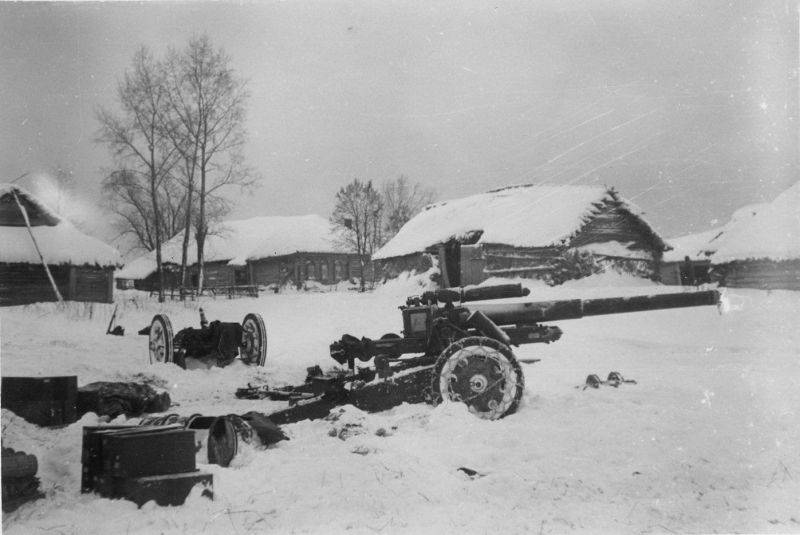
150 mm sFH18 heavy field howitzer, abandoned at a firing position
However, captured 150-mm howitzers began to be used in noticeable quantities in the summer of 1943, after the Red Army soldiers managed to master the guns captured at Stalingrad. By that time, the GAU had published firing tables translated into Russian, a detailed list of ammunition with their characteristics and operating instructions.
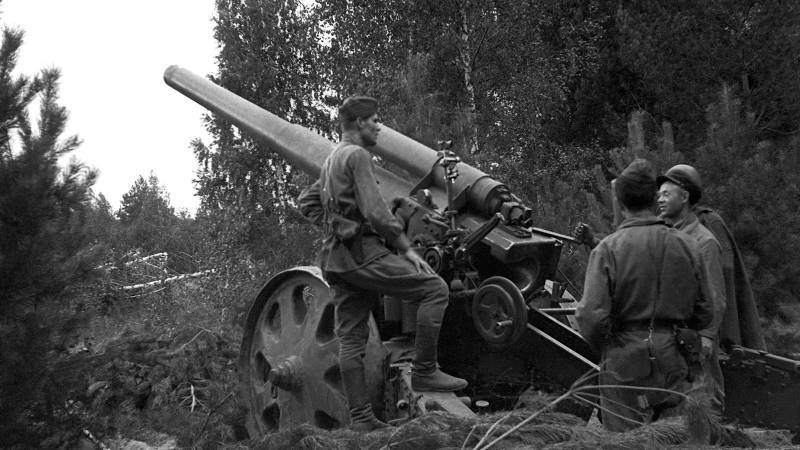
In the Red Army, this captured artillery system received the designation “150-mm German heavy field howitzer mod. 18".
Captured heavy howitzers and ammunition for them were regularly captured by our troops during offensive operations and were used until the end of hostilities.
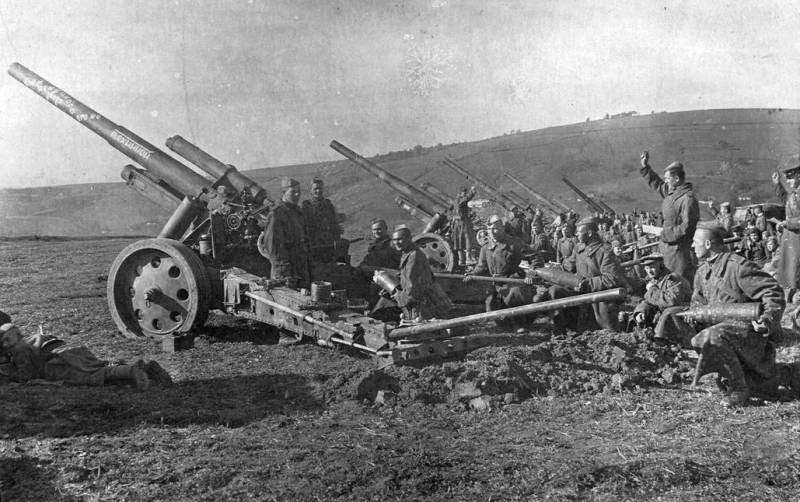
Several artillery regiments of corps artillery and brigades of the RVGK were armed with heavy howitzers sFH18. These guns also took part in the hostilities against Japan.
In the post-war period, captured 15 cm sFH18 howitzers were sent to storage bases, where they remained until the end of the 1950s.
Post-war use of captured heavy howitzers 15 cm sFH18
In the late 1930s, 24 guns were acquired by the Chinese government, which happened almost simultaneously with the shipment of 150 mm sFH18 howitzers to Spain. There is information that, according to a Chinese order, Friedrich Krupp AG has manufactured guns with an extended barrel. These howitzers, designated 15 cm sFH18/L32, had an increased firing range. Chinese artillerymen greatly valued and cherished 150-mm long-range howitzers, using them for counter-battery combat and shelling important targets deep in the Japanese defense.
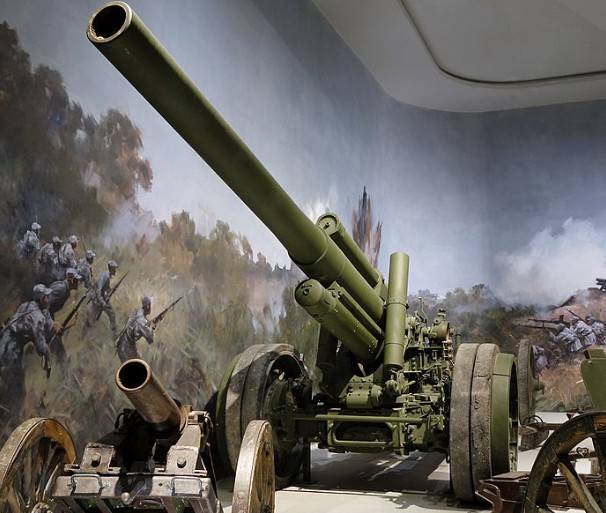
Currently, one German-made 150 mm heavy howitzer is on display at the Beijing Military Museum of the Chinese Revolution.
During World War II, some allied countries of the Third Reich received heavy 15 cm sFH18 field howitzers.
In 1940, Finland bought 48 15 cm sFH18 howitzers. The guns, designated 150 H/40, were actively used against Soviet troops until Finland left the war in 1944.
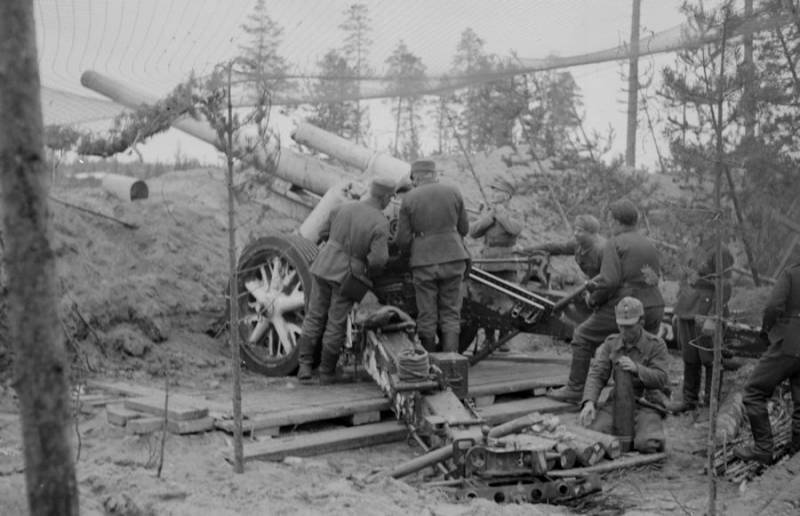
Heavy field howitzer 15 cm sFH18 with Finnish crew
During World War II, one howitzer was lost in combat. In the 1950s, German-made guns underwent restoration.
In the second half of the 1980s, heavy 150-mm German howitzers underwent a radical modernization. The most significant change was the replacement of the original barrels with 152 mm barrels with a muzzle brake, made in Finland. Changes were also made to the carriage; an armor shield was installed to protect the crew from fragments. The guns received new wheels with pneumatic tires, which increased their towing speed to 60 km/h.
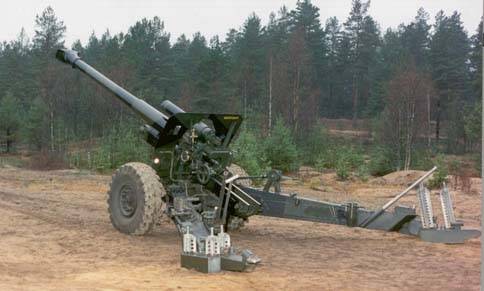
152 mm howitzer 152 H 88-40
42 howitzers went through the modernization program, which, under the designation 152 H 88-40, were in service until 2007.
In the post-war period, heavy howitzers produced in Germany were in service in Albania, Bulgaria, Indonesia, China, Poland, Portugal, Syria, Czechoslovakia and Yugoslavia.
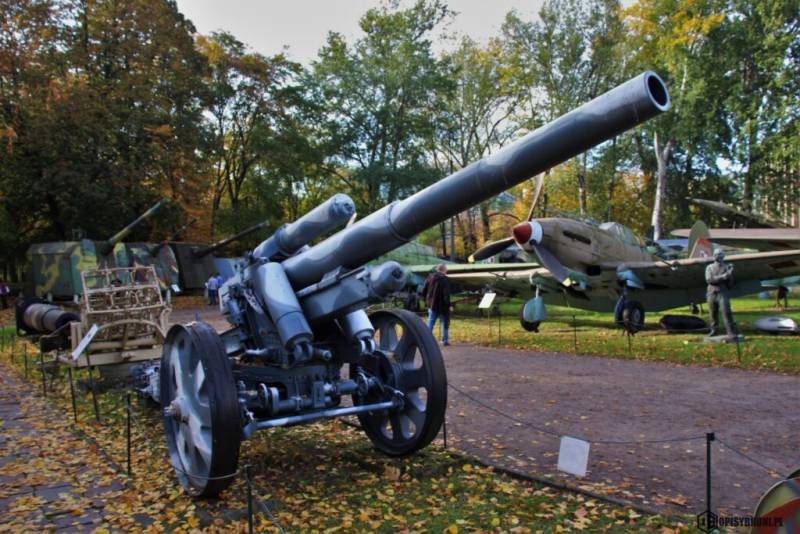
150 mm howitzer sFH18 in the Polish Army Museum, Warsaw
Several dozen 150-mm howitzers went to France, but the French army did not operate them for long; most of the guns were sold to Portugal in the early 1950s.
It is reliably known that in the post-war period, captured 15 cm sFH18 were used in combat operations by Syria and Portugal. Syrian howitzers took part in the 1967 war. The Portuguese, adopted under the designation Obus K 15 cm/30 m/941, attacked rebel positions in African colonies in the late 1960s and early 1970s.
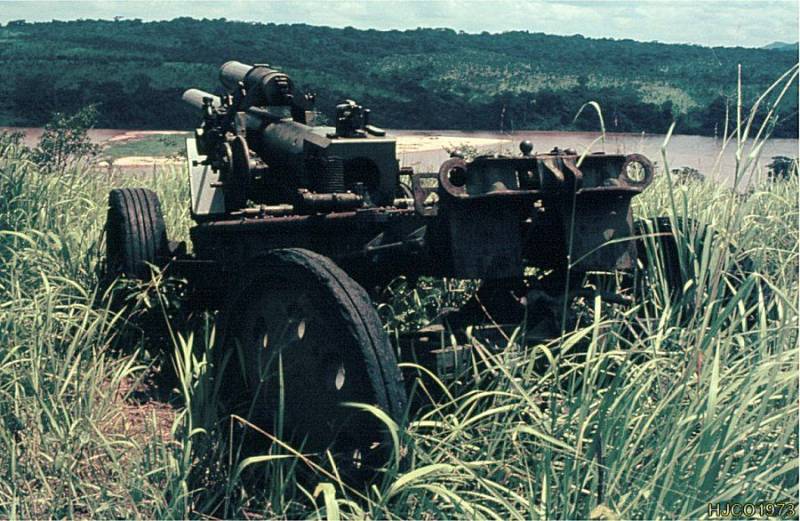
After the withdrawal of the Portuguese military contingent and Angola, Mozambique and Guinea-Bissau gaining independence, some of the heavy 150-mm howitzers were abandoned in Africa.
At the end of the 1940s, in connection with the transition to Soviet artillery calibers, the command of the Czechoslovak Army initiated the modernization of 15 cm sFH18 howitzers, of which there were about three hundred in service and in storage.
After analyzing all the options, it was decided to convert the 150-mm howitzers to a projectile from the 152-mm ML-20 howitzer-gun. During the conversion, the gun barrel was bored to a caliber of 152,4 mm. To reduce the load on the structural elements, the barrel was equipped with a muzzle brake.
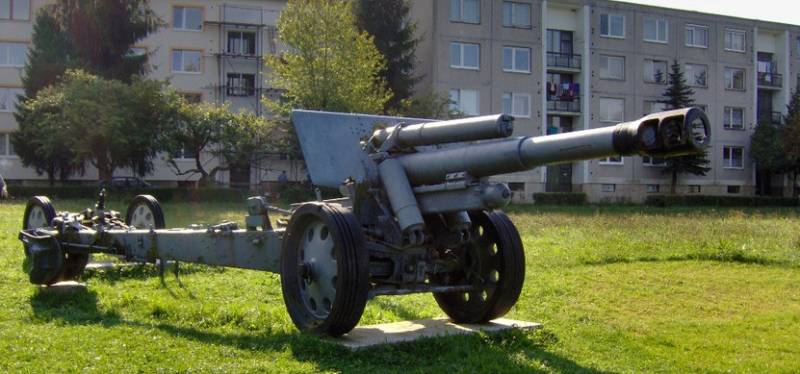
Howitzer 152 mm Houfnice vz. 18/47
According to Czech sources, the weight of the gun in the combat position was 5 kg, in the transport position - 588 kg. The initial projectile speed is 6 m/s. Maximum firing range – 550 m. Rate of fire – up to 580 rounds/min.
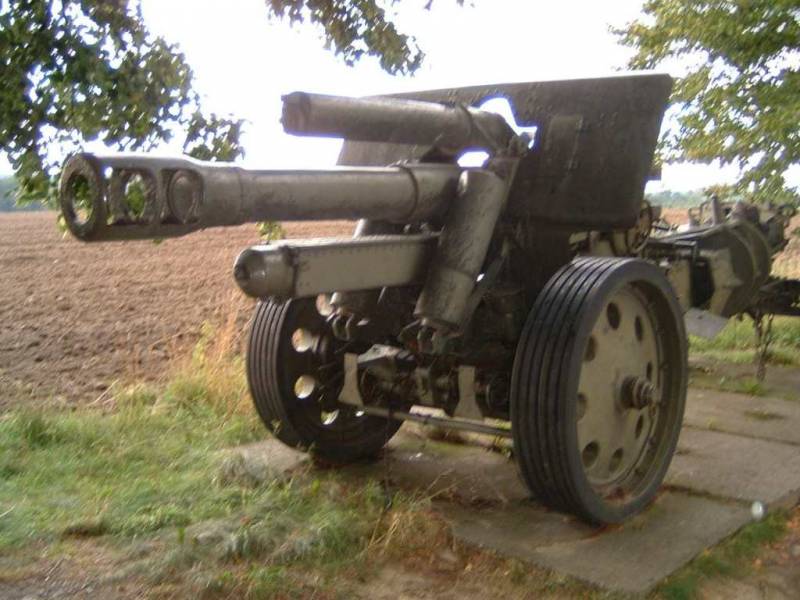
Modernized guns called 152 mm Houfnice vz. 18/47 entered service with artillery regiments of motorized rifle and tank divisions of the Czechoslovak People's Army. At the end of 1969, the Czechoslovak People's Army had a total of 247 vz. howitzers in service. 18/47.
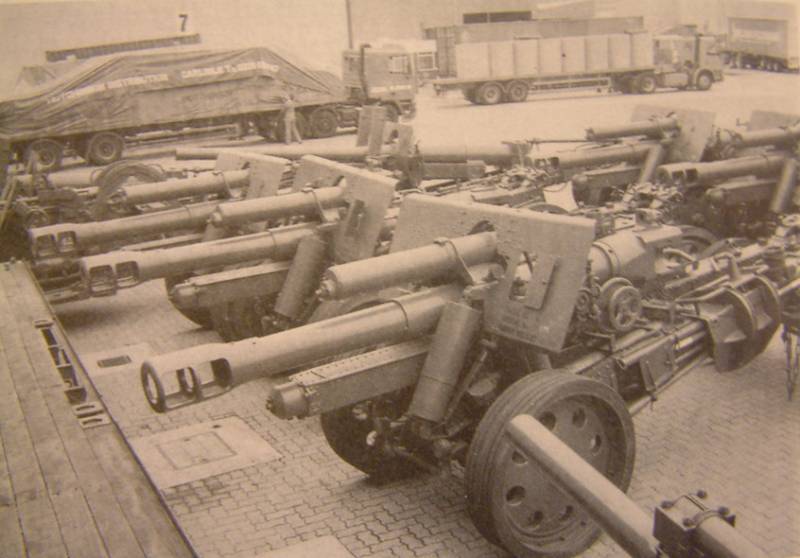
Since the late 1970s, vz. 18/47 in combat units began to be replaced with new self-propelled 152-mm howitzers vz.77 Dana, after which the German-Czech hybrid howitzers were transferred for storage. However, this process dragged on, and some Czechoslovak artillery units retained towed 152 mm vz. howitzers in service. 18/47 until 1994.
In the early 1960s, several dozen 152 mm vz. guns. 18/47 acquired by Syria. In this country, they were used in conjunction with Soviet 152-mm ML-20 gun-howitzers and D-1 howitzers. In 2015, howitzers vz. 18/47, taken from artillery reserve depots, took part in the fighting.
Продолжение следует ...
Information